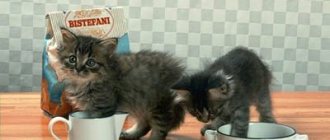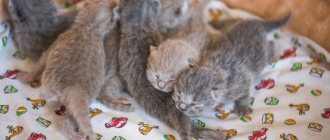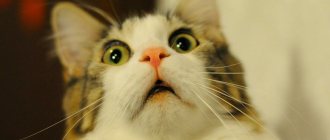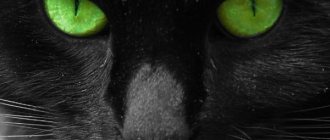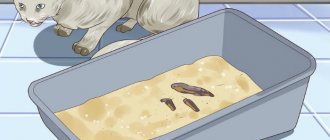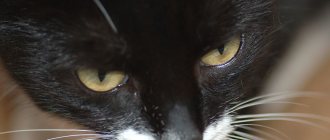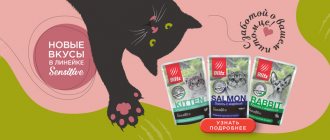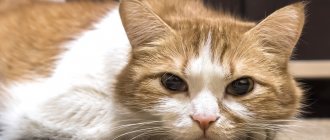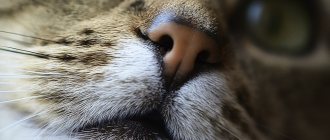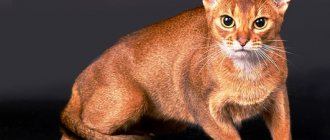For the first time, descriptions of colors and patterns in cats with a genetic basis appeared in “The Book of Cats,” 1980, and “Robinson’s Genetics,” 1977.
Genetically, there are four basic or solid colors: black, chocolate, cinnamon and red.
. All the rest - blue, lilac, fawn, cream - are modifications of the basic ones. The pigment eumelanin (black) or pheomelanin (red) in small granules is distributed evenly along the entire length of the hair from root to tip, which gives a single and uniform tone throughout the animal’s body. In the solid color standard, the simultaneous presence of residual patterns, other shades on the main background, “rust,” white hairs, and lighter undercoat is unacceptable. White is not a color because it represents the absence of pigment.
The name of the same color may depend on the rules adopted in felinology or the breed of the animal. Thus, black color in the Oriental breed is usually denoted as “ebony, ebony tabby”
,
“black”
in a solid group of short-haired cats,
“brown”
in the tabby group,
“bronze”
in the Egyptian Mau,
“wild”
in the Abyssinian breed.
In the color-point group, “black” is called “seal”
, in the Burmese it is called
“sable”
, etc.
Shaded, silver-veiled, and black smoke may appear gray or silvery. The dilutor (lightener) gene produces a blue color. The deluthor modifier gene is represented by a caramel group. But all these colors are genetically black. A special solid color is red. Oddly enough, all ginger cats are red tabbies, that is, they have a pattern. This is due to the non-agouti gene, which does not allow the pattern to appear, and we see a solid, uniform color in black cats. The non-agouti gene in red animals does not affect the deposition of pheomelanin in the hair, which is always manifested by a pattern in the color. Under the influence of other genes - polygenes and modifiers, this pattern has different intensity and contrast with the main one. Selection of ticked red color allowed to minimize the brightness and contrast of the pattern, but residual markers are present on the forehead, muzzle, paws, and tail of the animal.
“Caramelization” is a lightening modifier gene
In the 70s of the 20th century, the breeder of Orientals and Siamese Patricia Turner
When working with point and silver groups, I received kittens with new colors, which on the one hand were a little similar to the classic lightened ones (blue, lilac, fawn), on the other hand they were different from them.
Evaluation of pedigrees and experimental matings suggested that there is a new gene influencing the base color. Its effect was manifested only in those who had already bleached, for which it received the name bleaching modifier gene
.
It is located in another locus of the chromosome, therefore, in the presence of a dominant clarifier gene (genotype DD, Dd), it does not manifest itself. Animals with the lightening modifier gene always have a “caramel” color
and cannot be its carrier, since only its dominant variant appears.
Blue becomes gray or dark gray with a brown coating, chocolate becomes almost dark brown, cloudy (taupe color), lilac becomes coffee with milk, cream becomes hot apricot. Solid cats look a little dusty, while tabbies acquire a metallic sheen. The lightening modifier gene is designated Dm
. The recessive form dm has no effect on color. Like the lightening gene, the modifier affects the shape and arrangement of pigment particles in the hair. It is most common in cats of the eastern group, but recently it has begun to appear in other cultivated breeds.
aaBBdd/Bbdd/Bb'dd
(blue) ⟶
aaBBddDm/BbddDm/Bb'ddDm
(caramel based on blue)
aabbdd/bb'dd
(lilac) ⟶
aabbddDm/bb'ddDm
(taupe)
aab'b'dd
(faun) ⟶
aab'b'ddDm
(caramel based on faun)
aaOOdd/OOdd/oodd
(cream) ⟶
aaOOddDm/OoddDM/ooddDm
(apricot)
Main characteristics of color
A cat's coat can only be recognized as ticked if:
there is no extraneous pattern at all on the animal’s body - neither clear nor blurry;
On each hair on the animal’s fur there are several dark and light stripes (at least 3 dark stripes).
The ticked color of cats, among other things, allows for stripes on the tip of the tail and paws, the presence of a “necklace” on the neck, as well as stripes in the shape of the letter “M” on the forehead. Such drawings are not considered a reason for disqualifying cats of any breed except Abyssinian.
“Extender” genes, black modifier (colors Amber, Light Amber, Russet)
In the 1990s, “strange”
color
Outwardly, they resembled chocolate or cinnamon, but since this group of colors is not recognized for native breeds, they were registered as “blue gold”
.
Their offspring surprised the breeders even more; some kittens were born dark and began to lighten with age, acquiring a color from light apricot to cinnamon-red. There was no doubt that these cats were genetically black and not red. This is confirmed by pedigree assessment and control matings. In addition, these animals were not assigned to either the gold or silver groups, since their paw pads remained dark and their noses did not have a rim. Breeders thought about the genetic basis of the new colors, called Amber
(amber, originally black) and
Light Amber
(originally blue). It was experimentally confirmed that Amber can be both solid and tabby.
Black solid kittens are born with a uniform dark or black color with signs of a residual pattern, have eye rims, brown paw pads and a brown nose without a rim. They lighten as they mature to an apricot color, only the ends of the hair remain colored. The blue solid color becomes pink-beige with age, the nose, paw pads, and eye rims are gray-blue.
Black tabby kittens are born apricot with a black pattern that turns reddish-brown as they age. The paw pads and eye rims are brown, the nose is pink. Blue tabbies are beige with a blue pattern. Adult animals have a light pink or yellowish-brown pattern. The paw pads and eye rims are gray-blue, the nose is pink.
These observations suggested the presence in the genome of a new gene or group of genes that modify black color, affecting the distribution and composition of melanin in the hair. At the moment, the opinion has been confirmed that this gene is not related to the Agouti gene and is located in a different locus. Whether there is a relationship with the inhibitor gene in silvers or with the broad stripe gene in goldens remains debatable. The former name of this gene is Black modifier (Bm), the modern name is Extention gene
(extension gene). In addition to the Norwegian Forest Cat, the Amber and Light Amber colors appeared in the Kuril Bobtail breed.
Do cats change the color of their paw pads when they are sick?
Sudden, dramatic changes in the color of your cat's paw pads should be checked by a veterinarian as soon as possible. This includes discoloration of all paw pads or paleness of all four paws.
A slight change in color may indicate a less serious problem. Paw pads are susceptible to injury and cracking in adverse weather conditions. Although this is a relatively common occurrence, it can make jumping and general movement difficult.
What are paw pads?
The paw pads act as pads, bearing the brunt of the cat's weight when running and jumping. Paw pads provide traction to the paws and protect them from damage when walking on rough and abrasive surfaces.
There are several types of cat paw pads. There are metacarpal pads on the forelimbs, plantar pads on the hind limbs, and digital pads on each paw. They are made up of fatty tissues (collagen and adipose tissue).
In addition to shock absorption and traction, paw pads serve other functions. The ability of the paw pads to absorb shock enhances stealth, allowing cats to walk silently. They can also be used to mark territory.
How a cat's paw pads get their color
Color Russet (from the English russet - dark brown with a reddish tint)
The Russet first appeared in New Zealand in 2007 in the offspring of brown European Burmese who were carriers of the lightening and chocolate genes. Like Amber, kittens with "strange" colors changed as they grew older, becoming red. DNA testing showed that the kittens have the standard brown or chocolate gene. It was suggested that this is a manifestation of a certain recessive gene as a result of a spontaneous mutation, which causes eumelanin to gradually disappear and the red pigment to appear. Perhaps this is the influence of an expansion gene.
Red ticked
The coat of d 25 cats not only looks unusual due to the ticking, but is also very bright. The pattern on the body of such animals is deep red on a red background. The nose and mouth of ticked cats of this color are also surrounded by a rim of the same color.
The eyes of animals in this group can range in color from yellow to brown. The nose and paw pads are brick red.
Cat paw print
The print of a cat's paw is round, without traces of claws, because representatives of the family walk with retracted claws that do not touch the ground. The paws leave a mark of four toes and, no matter the hind leg or the front leg, and the metacarpal soft. The two front fingers are located in close proximity to each other, while the side ones are slightly distant from the central ones. When landing a jump, a profitable fingerprint may be left behind. When pursuing prey, the tracks of the four legs come closer together.
28.11.2017
“O little queen without a kingdom, rootless conqueror, miniature lazy tigress, you catch a wave of love in the air as you walk, barely touching the ground with your paws, sniffing suspiciously at all objects, because everything seems dirty to you in contact with your unsullied paws, oh cat. "(Adriano Bacchella. Cats)
Cat's paws deserve the closest attention and a separate story, they are so important for all aspects of a cat's life.
They are cute and fluffy, soft and graceful - you just want to pet them (which is not always what our pets like)..
But a cat's paws are also a versatile and important part of a cat's body, helping it perform a variety of actions and increasing the animal's chances of survival in the wild.
Did you know that a cat uses its paws for many purposes:
- communication with humans and other animals
- checking the environment for hazards
- hunting and defense
- caring for your hair
- body temperature regulation
- clinging to objects and deft climbing
- shock absorption during jumps or falls
- food and drink
- complacency
This story provides some interesting facts about cats' paws, their pads and claws, and how skillfully the animals use them.
1. A cat normally has five toes on its front paws and four on its back paws, unless it is multi-digitated (six or more toes)
The multi-fingered mutation in cats is called polydactyly (from the Greek poly, meaning many, and dactylos, fingers).
Multi-fingered cats are also called “Hemingway’s cats” because a large flock of six-fingered cats lived in the famous writer’s house.
Polydactyly is a genetic inheritance, not a defect. These cats perceive this as a positive trait and use the extra toe to improve stability and agility. There is a belief that polydactic cats bring good luck and happiness to the house.
